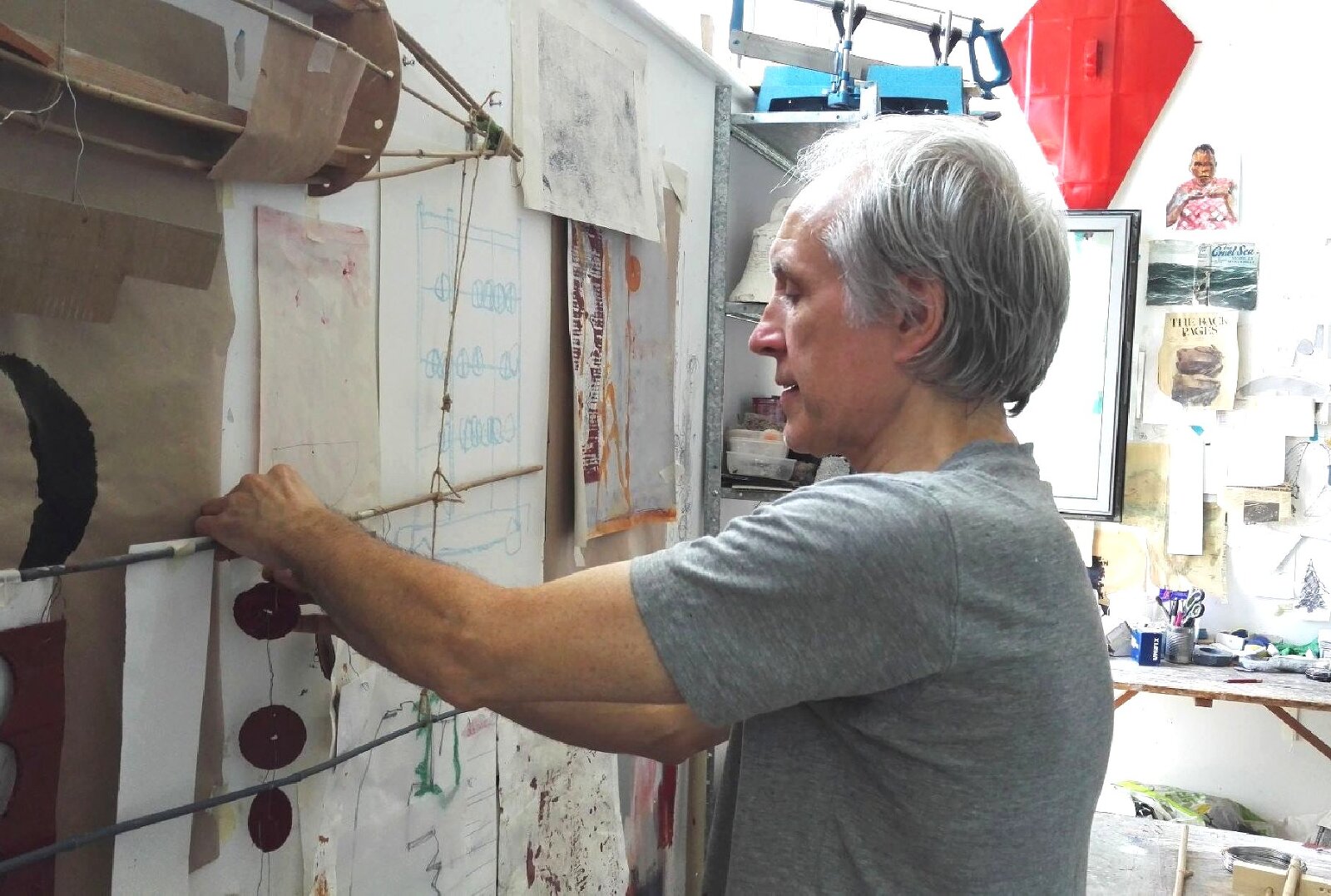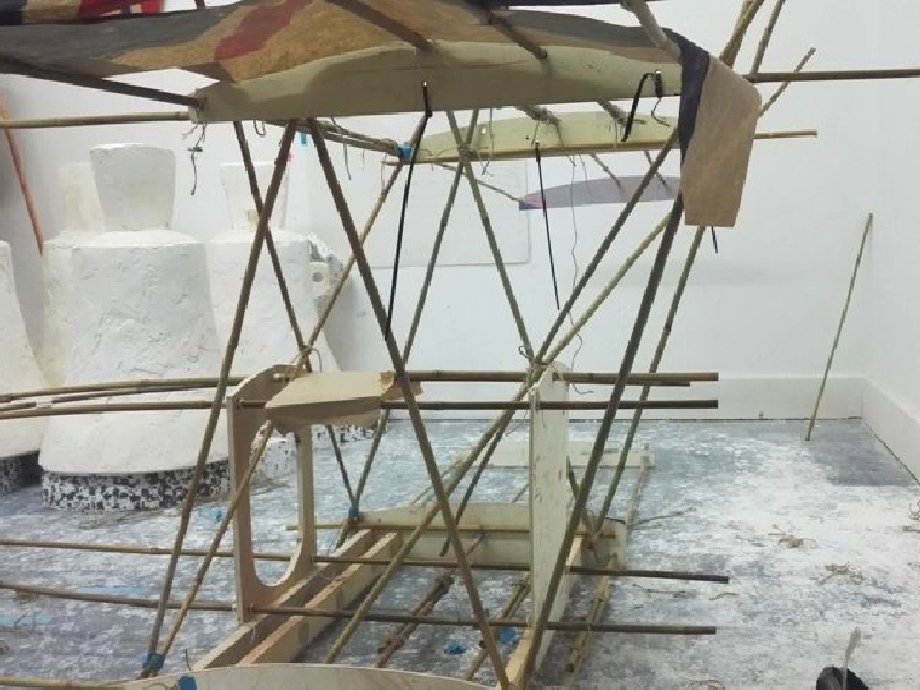“Art, whatever it takes”
The RomeArtProgram has made a series of interviews with Artists living in Italy, the USA & the UK
to know their feelings and orientation during these times of emergency.
Keith Roberts is a British sculptor & painter based in London.
Trained at Royal College of Art, he had a major art award to the British School at Rome and is spending periods of study and research in Italy. He is a RAP visiting artist in 2021, lecturing on his work and critiquing student work in Rome.
RAP – Where do you live ? And what is your background?
Keith: I live in South East London between Peckham and Deptford. My studio is now mercifully close to my home but I almost always cycle into Deptford first and look at the River. Watch the state of the tide and draw the working boats and wharves that still just about give the flavour of a once busy port. I grew up in the south of London where from this distance it seems that I mostly rode a bicycle and drew obsessively from pictures of Michelangelo’s drawings. It was only after I had left the Army that I began to engage in the arts. My friends were all in bands and I started to make artwork for them. I ended up falling into a brilliant foundation course at Camberwell School of Art and so to the British School at Rome.
RAP – In your opinion is there a “creative method”?
Keith: I think that work comes from work but that is easier said than done. I try and understand the world through drawing, so that is usually where thoughts turn into something tangible something that you can hold in your hand and will exist after you have left the room. As a piece develops there will be many additions and more subtractions; a reductive process that seeks to arrive at just the right point.
RAP – The “lock down moment” can set you on the path of some important change(s) in your creativity and style…Has this happened to you?
Keith: The lockdown moment lent an urgency to my endeavours but robbed me of the chance and ability to fulfil them. At least for that moment. Very soon though I able to get into my studio and the materials that were there. I realised that this is what I had to use, nothing more, and felt strangely energised by the challenge. Good art can be made from what is to hand. The lockdown moment has made me want to push harder and be direct.
RAP – What normally inspires you? Which is the most important inspirational source you have found in Rome?
Keith: My tutor at Newcastle upon Tyne Polytechnic would be shaking his head now as it was decided that inspiration doesn’t exist! However, what it is that sparks new ideas and creates unexpected connections can come from anywhere I’ve found. An overheard snippet of conversation, a line in a book on Industrialised farming, graffiti carved into the marble along the Appian Way. The Eternal City itself was an inspiration. I endlessly walked the streets: walking in the footsteps of those before me. The tufa wearing at my shoes. The art in its original setting. The layering of the past with the present and seamlessly so. The people I spoke with. Thinking back to my first visit I remember the glory of Rome being its water. The fountains in the grand piazzas yes, but more so the small drinking fountains burbling and spluttering on the street corners tucked away and constant.
RAP – Is there a difference in working in Rome for an artist? What art medium do you prefer to work in?
Keith: Making paintings in Rome was a tremendous experience. Every city is unique and you absorb the light and smell and the touch of its stone into your practice, consciously or not. But you have to hold your nerve. A great city like Rome with its history and cultural enormity can crush you under its weight.
Gathering materials in Rome to paint and draw with was a rewarding and sometimes embarrassing experience. I arrived with nothing and no expectations about what I would make there. Finding materials was a good way to engage with the city. I made a lot of works on paper and wood but chose to make oil paintings on canvas for an exhibition there.
RAP – Specific events and historical conditions have a significant role in the creative process; how does this pandemic emergency affect the Arts?
Keith: The Arts as a structural thing has been wounded but Art survives, gathering new things to itself and finding new ways of making. The pandemic will be woven into what is made, or danced or sung.
RAP – How are you feeling at this difficult moment and what made you feel this way? …are you optimistic for the future?
Keith: At the moment I have a low burning anger at the paltry responses to the pandemic by a government caught up in webs of conflicting political dogma. On the other hand I am optimistic for the future. Good and bad will continue to wrestle but we shall move forward nevertheless.
RAP – What can Art contribute to history? Will “Art save us” ?
Keith: Art and History seem bound together. Would people looking at our present time be able to tease apart where history and art sit?
RAP – What is your most ambitious dream?…and the greatest sacrifice that you have made for your Art?
Keith: To make a piece of work that astonishes me. It may not happen but I try.
RAP – Recently, the artistic and cultural message of Italy and Rome was reemerging as a great “work in progress”, …is this your point of view?
Keith: Both art and culture are and should be a continual work in progress. The alternative is to become petrified and stuck.
RAP – Which is your favorite Italian, or Roman, place(s) of art (Museum, Gallery, Monument…) ?
Keith: To pluck things from the air: The Pantheon. The construction, the age, the misleading dedication and most of all the genius of its oculus. The Tazza d’Oro café nearby where visiting for the first time I was very confused but ultimately refreshed. A shop in Antica Ostia that is essentially a sports bar we would recognise today. Must also mention being struck by the paved area around the Duomo in Florence.
RAP – Which period of Italian Art do you prefer? What is your favorite Italian work of art?
Keith: I see art history as essentially a fluid thing. So the achievements of Masaccio sit alongside those of Michelangelo and Caravaggio and the wonder of Bernini and so on.
My favourite piece of work is the Rondanini Pieta in Milan by Michelangelo. I see the seeking of a truth and resolution always just beyond the point of the chisel.
RAP – How has Rome personally influenced you as an artist and a person?
Keith: I carry my experiences of Rome with me still. It was there that I first cut in to the picture plane and so to another way of making. The layers of the city stay with me from the deep past to the present; mixing together, heady and sustaining. The lessons learned from people outside the world of art; the modern language scholar who wouldn’t let me drown in the past and the archaeologist who taught me to read signs in the pavement at my feet.
RAP – What’s your goal? What role does the artist have in society? Any final thoughts and advice…
Keith: My goal is to work harder, remain curious and be engaged with the world.
keithrobertsartist.com
The RomeArtProgram is ready to bounce back!
_____________________
RomeArtProgram
#romeartprogram
Art-as-Power


